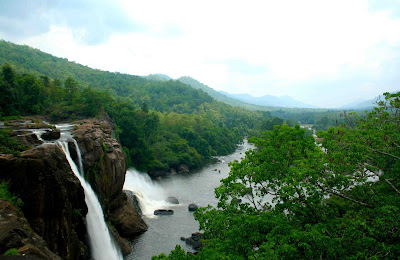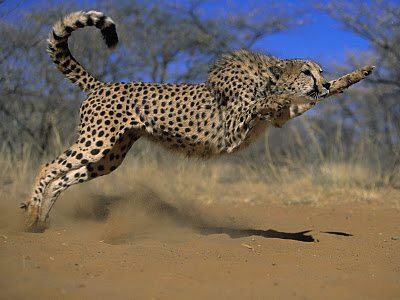Athirappilly WaterFalls
Athirappilly Falls : is in the neighboring Thrissur district and is around 60 km fromKochi. The Chalakudy River, 145 kilometres (90 mi) long, originates in the Anamudimountains (Western Ghats)[12] and flows through the Vazhachal Forest toward the Arabian Sea. Forest wildlife includes the Asiatic elephant, tiger, leopard, bison, sambar, and lion-tailed macaque.- Plantations in the area contain teak, bamboo, and eucalyptus. The river initially runs smoothly but becomes more turbulent as it nears Athirappilly. At Athirappilly Falls, the water surges around big rocks and cascades down in three separate plumes.
- Below the falls, the river remains turbulent for about1 kilometre (0.6 mi) until it reaches Kannamkuzhi. Then it calms and flows smoothly until reaching the dam at Imburmuzhi.
- The Athirappilly Falls is situated 1000 ft above sea level on the Chalakudy river, at the entrance to the Sholayar ranges of the Western Ghats, Athirappalli is a scenic combination of forests and little streams. Falling from a height of 80 feet, this is one of the largest waterfalls in the state.
- Many endangered and endemic species of flora and fauna are found in the forests of the Athirapilly-Vazhachal area. This area is the only place in the Western Ghats where four endangered Hornbill species are seen.
- The Western Ghats is one of the most important biodiversity hot spot in the world. This valuable natural world is already degraded by mining and hydro electric projects. Environmentalists claim that Athirapally is a one-of its-kind riparian ecosystem in Kerala.
- V.S. Vijayan, Chairman of the Kerala State Biodiversity Board and former Director of the Salim Ali Centre for Ornithology and Natural History (SACON), Coimbatore, has been quoted in Down to Earth magazine as affirming that the Vazhachal forest division is the second most biodiverse area in the State.
- The International Bird Association has declared it an "Important Bird Area" and the Asian Nature Conservation Foundation has recommended that the area should be declared a sanctuary or a national park, he points out.
- The Wildlife Trust of India says it represents one of India's best elephant conservation efforts. “Any disruption to this fragile ecosystem will spell disaster,” says Vijayan
Route
through Valparai :
Coimbatore-Pollachi 40 km-Valparai
65 km From Pollachi onwards, the road climbs up steeply through
tea estates to Valparai. From Valparai, the road goes through dense
wild jungles after Malakkiparai. Route is as follows:
Valparai-Malakkiparai 22 km-Sholayar 24-Peringalkuthu Dam
25-Vazhachal 5-Athirapalli 5-Chalakudy 33 km.
Route
through Angamaly :
For tourists from Cochin and other
northern side of Kerala can take a short cut from Angamaly. After
Passing Angamaly take right turn after the bridge. This route will
pass through Mookkannoor, Edalakadu, Ezhattumugham, Palm Oil
Plantation and connect to Athirapilly Vazhachal route. This route can
save time, distance and you can enjoy nature.
Route
through Chalakudy :
For tourists from Chalakudy and other
southern side of Kerala can take the Athirappilly route starting from
Anamala Jn. Chalakudy and pass through Kanjirapilly, Vettilapara
Athirapilly route.
There
is absolutely no human settlement between Malakkiparai and
Peringalkuthu Dam. Wildlife—elephants and bison—spill over onto
the road, and night driving is discouraged. Both Vazhachal and
Athirapalli are on the same Chalakudy river.
Athirapalli
falls is best visited during rains, rest of the year there is water
flow but hardly the spectacle it is during Jun–Oct.
There
are two water theme parks (Silver Storm and Dream Word) and many
resorts on the way to Athirapilly.
Forest wildlife Animals
Asian Elephant :
The
Asian or Asiatic elephant (Elephas maximus) is
the only living species of the genus Elephas
and is distributed in Southeast
Asia from India
in the west to Borneo
in the east. Three subspecies are recognized — Elephas
maximus maximus from Sri
Lanka, the Indian
elephant or E. m. indicus from mainland Asia, and E.
m. sumatranus from the island of Sumatra.[1]
Asian elephants are the largest living land animals in Asia.[4]
In 2003, the wild population was estimated at between 41,410 and 52,345 individuals. Female captive elephants have lived beyond 60 years when kept in seminatural situations, such as forest camps. In zoos, elephants die at a much younger age and are declining due to a low birth and high death rate.
Tiger:
The
tiger (Panthera tigris) is the largest cat
species, reaching a total body length of up to 3.3 m (11 ft)
and weighing up to 306 kg (670 lb). It is the third largest
land carnivore
(behind only the polar
bear and the brown
bear). Its most recognizable feature is a pattern of dark
vertical stripes on reddish-orange fur with a lighter underside. It
has exceptionally stout teeth, and the canines
are the longest among living felids with a crown
height of as much as 74.5 mm (2.93 in) or even 90 mm
(3.5 in).[4]
In zoos, tigers have lived for 20 to 26 years, which also seems to be
their longevity in the wild.[5]
They are territorial and generally solitary
but social animals, often requiring large contiguous areas of
habitat that support their prey requirements. This, coupled with the
fact that they are indigenous to some of the more densely populated
places on Earth, has caused significant conflicts with humans.
The global population in the wild is estimated to number between 3,062 and 3,948 individuals, down from around 100,000 at the start of the 20th century,[6] with most remaining populations occurring in small pockets isolated from each other. Major reasons for population decline include habitat destruction, habitat fragmentation and poaching.[1] The extent of area occupied by tigers is estimated at less than 1,184,911 km2 (457,497 sq mi), a 41% decline from the area estimated in the mid-1990s.
Leopad :
The
leopard (Panthera pardus) is a member of the Felidae
family
with a wide range in some parts of Africa
and tropical Asia,
from Siberia,
South and West
Asia to across most of sub-Saharan
Africa. It is listed as Near
Threatened on the IUCN
Red List because it is declining in large parts of its range due
to habitat loss
and fragmentation, and hunting for trade
and pest control. It is regionally extinct in Hong
Kong, Singapore,
Kuwait, Syrian
Arab Republic, Libya
and Tunisia.
The
leopard /ˈlɛpərd/
is the smallest of the four "big
cats" in the genus
Panthera.
Compared to other members of the Felidae, the leopard has relatively
short legs and a long body with a large skull. It is similar in
appearance to the jaguar,
but is smaller and more slightly built. Its fur is marked with
rosettes
similar to those of the jaguar, but the leopard's rosettes are
smaller and more densely packed, and do not usually have central
spots as the jaguars do. Both leopards and jaguars that are
melanistic are
known as black
panthers.
Leopards
show a great diversity in coat color and rosettes
patterns. In general, the coat color varies from pale yellow to deep
gold or tawny, and is patterned with black rosettes. The head, lower
limbs and belly are spotted with solid black. Coat color and
patterning are broadly associated with habitat type. Their rosettes
are circular in East
Africa but tend to be squarer in southern Africa and larger in
Asian populations.
Their yellow coat tends to be more pale and cream
colored in desert populations, more gray in colder climates, and of a
darker golden hue in rainforest
habitats. Overall, the fur under the belly tends to be lighter
coloured and of a softer, downy type. Solid black spots in place of
open rosettes are generally seen along the face, limbs and underbelly
Bison:
Bison
are large, even-toed
ungulates in the genus Bison within the subfamily Bovinae.
There are two surviving species; the American bison, Bison bison, also known as the American buffalo, found only in North America, is the most numerous. (It is only distantly related to the true buffalo.) The North American species is composed of two subspecies, the plains bison, Bison bison bison, and the wood bison, Bison bison athabascae, which is the namesake of Wood Buffalo National Park in Canada. The European bison Bison bonasus, or wisent is found in Europe and the Caucasus, re-introduced after being extinct in the wild.
While all bison species are usually grouped into their own genus, they are sometimes included in the closely related genus Bos,[1] together with cattle, gaur, kouprey and yaks, with which bison have a limited ability to interbreed.




































No comments:
Post a Comment